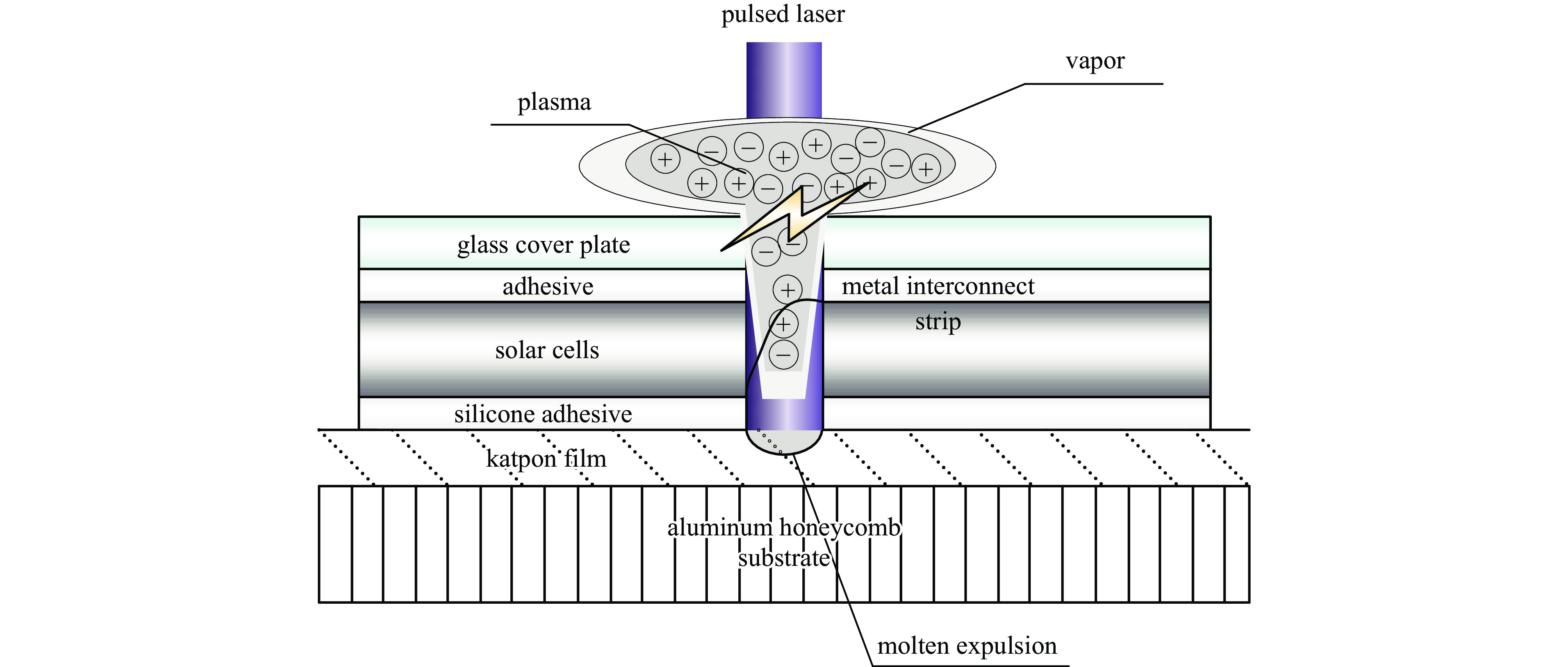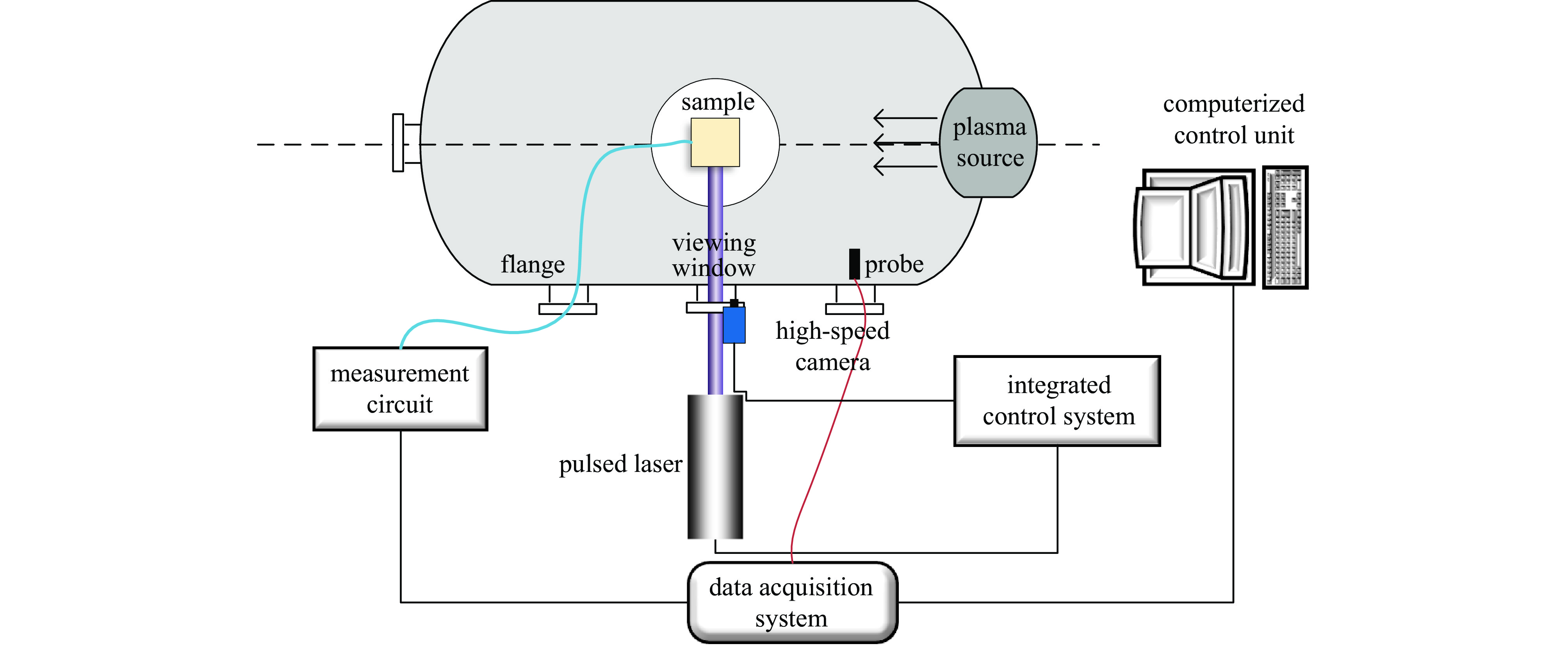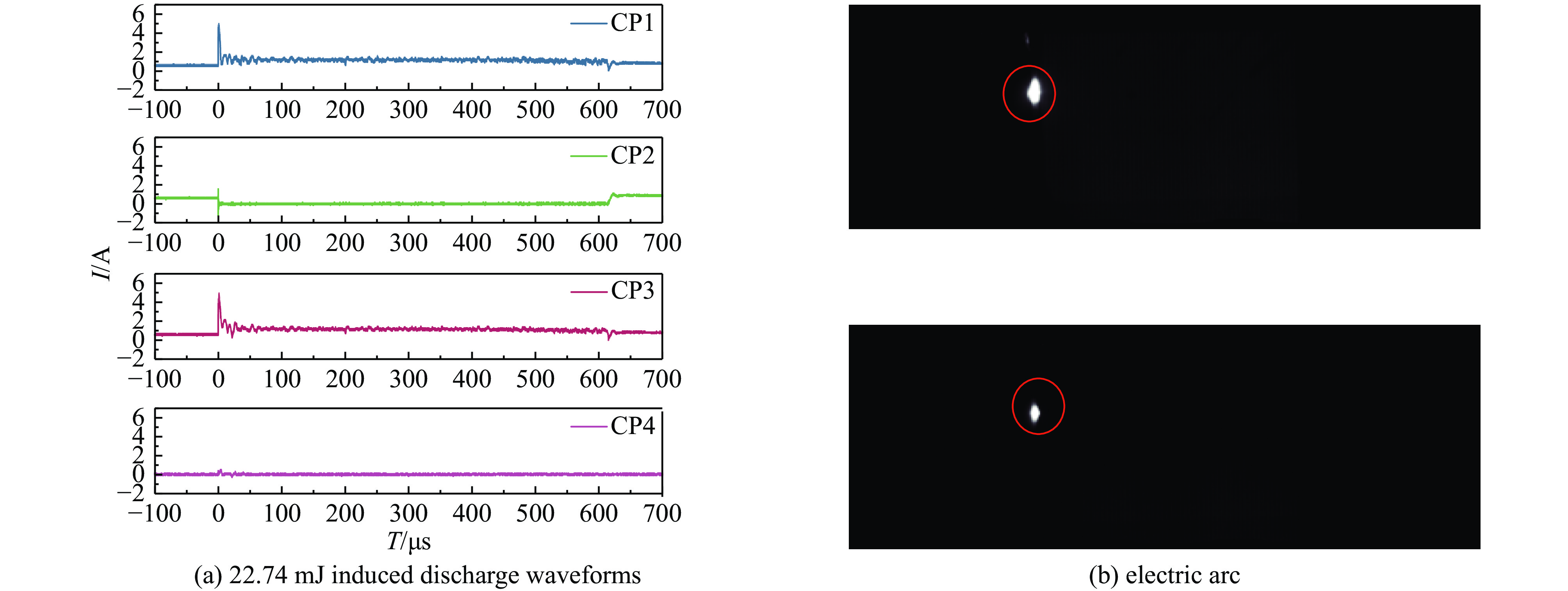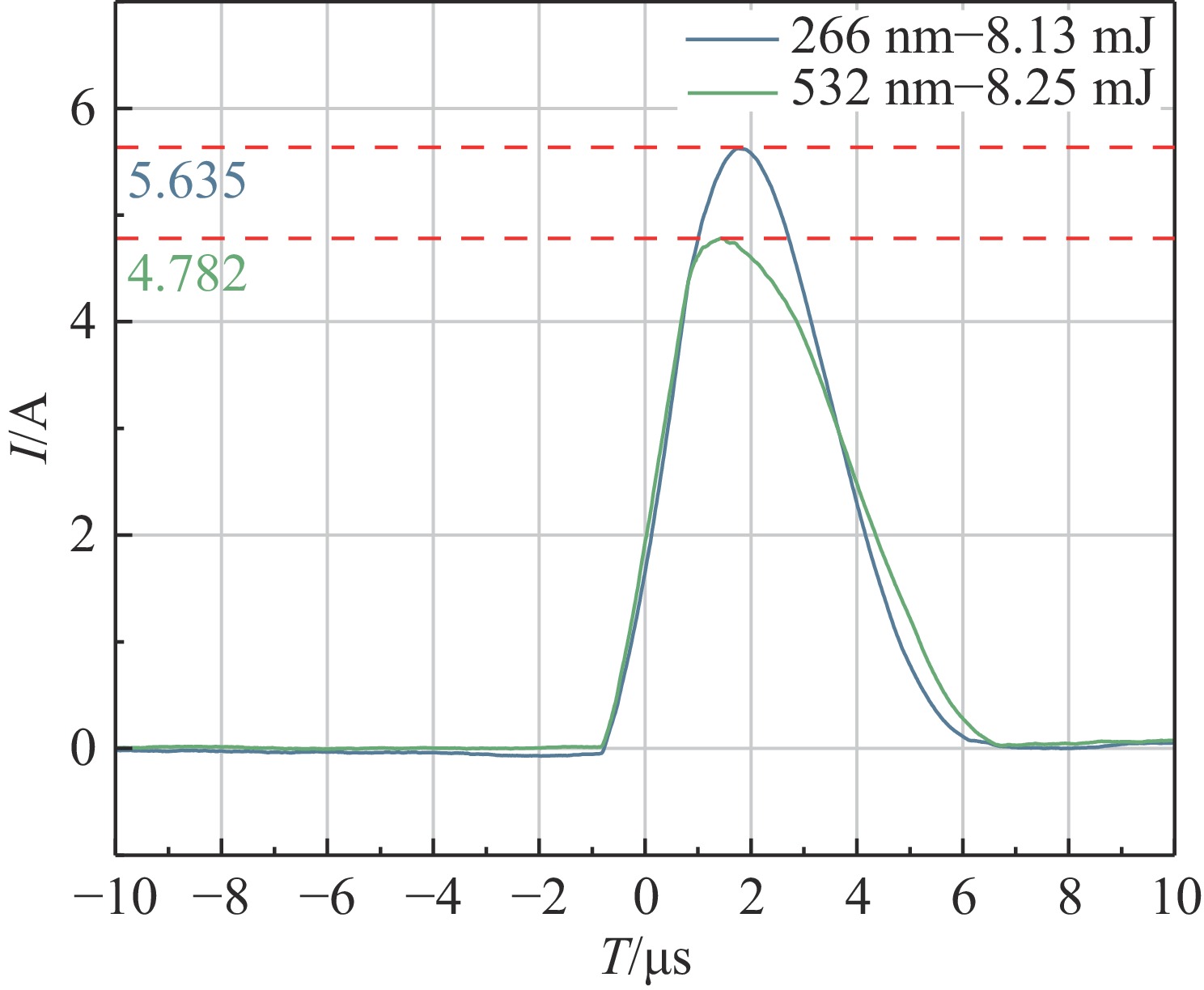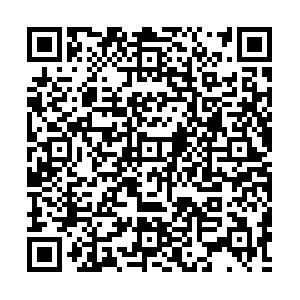Characterization of laser-induced spacecraft solar array discharges
-
摘要: 强激光在空间太阳能电站无线能量传输(WPT)过程中可能对其他航天器产生影响,特别是对航天器的太阳电池阵,可能诱发航天器太阳电池阵放电。掌握激光诱发航天器太阳电池阵放电特性,对支撑强激光无线能量传输技术发展有重要作用。开展激光能量与波长两个参量对激光诱发太阳能电池阵放电特性的影响研究。基于激光诱导等离子体理论和低地球轨道(LEO)等离子环境下的放电机理,分析了激光诱发太阳电池阵放电的机制,并基于该机制理论指定了激光诱发航天器太阳电池阵放电试验的试验参数。试验分析了532 nm波长不同能量激光诱发太阳电池阵放电的概率,并获取放电时间数据,建立时间概率分布曲线,通过二重泊松分布拟合,获得不同能量激光诱发太阳电池阵放电持续时间的概率函数;对比研究了相同能量下532 nm与266 nm两种波长激光诱发太阳电池阵放电的电流峰值以及持续时间概率函数。研究结果显示激光波长越短、能量越高,诱发太阳电池阵放电风险越高。Abstract:
Background The use of high-power lasers for Wireless Power Transmission (WPT) in space-based solar power stations poses a potential risk to orbiting spacecraft. Misalignment or system failures could cause the laser beam to irradiate a spacecraft's solar array, potentially inducing discharge phenomena that threaten the spacecraft's safety. Existing research has primarily focused on the thermal damage effects of lasers on solar arrays, while studies on the characteristics of laser-induced discharge remain insufficient.Purpose This study aims to systematically investigate the influence of two key laser parameters, energy and wavelength, on the discharge characteristics of spacecraft solar arrays. The goal is to reveal the underlying mechanisms of laser-induced discharge, thereby providing a theoretical and experimental basis for the safe application of high-power laser wireless energy transmission technology.Methods The mechanism of laser-induced solar array discharge was analyzed based on laser-induced plasma theory and discharge mechanisms within the Low Earth Orbit (LEO) plasma environment. Guided by this theoretical framework, the experimental parameters for the laser-induced spacecraft solar array discharge test were determined. The experiment analyzed the probability of discharge induced by a 532 nm laser at different energy levels and acquired discharge duration data. Probability-time distribution curves were established, and the probability functions for discharge duration under different laser energies were obtained by fitting with a double Poisson distribution. Furthermore, a comparative study was conducted on the peak discharge current and the duration probability functions induced by 532 nm and 266 nm wavelength lasers at the same energy level.Results The experimental results demonstrate that higher laser energy leads to a greater probability of induced discharge and longer discharge durations. Shorter laser wavelengths result in a lower discharge threshold and induce discharge events with higher peak currents. The discharge risk parameter increases significantly with shorter wavelength and higher energy.Conclusions Laser energy and wavelength are critical factors affecting the discharge risk of solar arrays. Short-wavelength, high-energy lasers pose a greater threat to solar array safety. The findings of this study provide important guidance for selecting laser parameters in WPT systems and for designing protective measures for solar arrays. -
Materials $\rho $/(kg·m−3) $ {c_p} $/(J/(kg·K)) k/(W/(m·K)) $ {T_m} $/K $ {T_\upsilon } $/K $ L{}_m $/(kJ·kg−1) $ {L_\upsilon } $/(kJ·kg−1) $\alpha $ $ {E_{inm}} $/mJ Ge 5350 322 60 1211.15 3093.15 508 4600 1064 nm-0.5
532 nm-0.6
266 nm-0.918.84
15.70
10.46GaAs 5370 322 60 1515.15 2466.15 746 956 1064 nm-0.4
532 nm-0.65
266 nm-0.939.43
5.80
4.06Kapton 1350 815 0.28 823.15 973.15 230 275 1064 nm-0.0002
532 nm-0.15
266 nm-0.67178.47
0.24
0.05表 2 试验系统参数
Table 2. Experimental system parameters
pressure/Pa Plasma density/m−3 Electron temperature/eV Wavelength/nm Pulse width/ns Spot diameter/mm Ub/V Rb/MΩ Cext/nF 4×10−3 1×1011~1×1012 2 532/266 5 1 180 10 50 表 3 试验结果
Table 3. Test results
No. E/mJ Tmax/μs n1/(n0+ n1) PE/% 1 22.75 740.95435 43/45 95.6 2 16.54 665.58411 39/45 86.7 3 11.69 514.85328 37/45 82.2 4 8.25 235.67812 25/45 55.6 5 4.81 106.33993 25/45 55.6 -
[1] 李欣宇, 罗雨, 叶薇薇, 等. 无线电能传输技术在空间太阳能电站中的研究与应用现状分析[J]. 电子技术应用, 2024, 50(5): 111-115Li Xinyu, Luo Yu, Ye Weiwei, et al. Research and application status analysis of wireless power transfer technology in space solar power station[J]. Application of Electronic Technique, 2024, 50(5): 111-115 [2] Li Wang. Overview on space solar power station[J]. Advances in Astronautics Science and Technology, 2022, 5(1): 1-2. doi: 10.1007/s42423-022-00101-z [3] Ding Yun, Yang Jingyu, Hao Yun. A review on coordinated control of formation configuration of space solar power station energy transmission system[J]. Journal of Aeronautics, Astronautics and Aviation, 2022, 54(1): 49-66. [4] Zhang Caiping, Zhang Chengning, Sharkh S M. Estimation of real-time peak power capability of a traction battery pack used in an HEV[C]//Proceedings of 2010 Asia-Pacific Power and Energy Engineering Conference. 2010: 1-6. [5] 仲元昌, 魏莹莹, 姚博文, 等. 空间太阳能电站的发展及关键技术综述[J]. 电源技术, 2019, 43(6): 1063-1066Zhong Yuanchang, Wei Yingying, Yao Bowen, et al. Development and key technologies of space solar power station[J]. Chinese Journal of Power Sources, 2019, 43(6): 1063-1066 [6] Wang Jixiang, Zhong Mingliang, Wu Zhe, et al. Ground-based investigation of a directional, flexible, and wireless concentrated solar energy transmission system[J]. Applied Energy, 2022, 322: 119517. doi: 10.1016/j.apenergy.2022.119517 [7] Stuart B C, Feit M D, Rubenchik A M, et al. Laser-induced damage in dielectrics with nanosecond to subpicosecond pulses[J]. Physical Review Letters, 1994, 74(12): 2248-2251. [8] 苏彬, 张琦, 张伟, 等. 空间三结砷化镓太阳电池的激光防护研究[J]. 电源技术, 2022, 46(9): 1030-1033Su Bin, Zhang Qi, Zhang Wei, et al. Study on the laser protection for space tri-junction GaAs solar cells[J]. Chinese Journal of Power Sources, 2022, 46(9): 1030-1033 [9] 吕伟, 郄毅鹏, 苏彬. 激光器损伤太阳电池研究[C]//第二十七届全国化学与物理电源学术年会论文集. 2006: 484-485Lv Wei, Qie Yipeng, Su Bin. Laser damage solar cell research[C]//Proceedings of the 27th Annual Meeting of the National Academic Society for Chemical and Physical Power Supplies. 2006: 484-485 [10] Qi Lei, Xie Yanxin, Liu Yali, et al. Thermal-stress distribution and damage characteristics of three-junction GaAs solar cell irradiated by continuous laser beam[J]. Optik, 2019, 198: 163284. doi: 10.1016/j.ijleo.2019.163284 [11] 唐道远, 徐建明, 李云鹏, 等. 三结砷化镓太阳电池真空连续激光损伤效应[J]. 上海航天(中英文), 2020, 37(2): 54-60Tang Daoyuan, Xu Jianming, Li Yunpeng, et al. Damage effects of tri-junction GaAs solar cells irradiated by continuous wave laser in vacuum[J]. Aerospace Shanghai (Chinese & English), 2020, 37(2): 54-60 [12] 常浩, 陈一夫, 周伟静, 等. 纳秒激光脉冲辐照太阳能电池损伤特性及对光电转化的影响[J]. 红外与激光工程, 2021, 50: 20210296 doi: 10.3788/IRLA20210296Chang Hao, Chen Yifu, Zhou Weijing, et al. Damage characteristics of the solar cells irradiated by nanosecond pulsed lasers and the effects on photoelectric conversion[J]. Infrared and Laser Engineering, 2021, 50: 20210296 doi: 10.3788/IRLA20210296 [13] 陆健, 谢知健, 张宏超. 连续激光辐照硅太阳电池损伤特性的光束诱导电流表征[J]. 红外与激光工程, 2022, 51: 20220022 doi: 10.3788/IRLA20220022Lu Jian, Xie Zhijian, Zhang Hongchao. Light beam induced current mapping to characterize damage characteristics of silicon solar cell irradiated by continuous-wave laser[J]. Infrared and Laser Engineering, 2022, 51: 20220022 doi: 10.3788/IRLA20220022 [14] Li Sai, Huang Longcheng, Ye Jifei, et al. Study on radiation damage of silicon solar cell electrical parameters by nanosecond pulse laser[J]. Electronics, 2024, 13(9): 1795. doi: 10.3390/electronics13091795 [15] Solin J R. Ground based laser triggered discharges on satellite solar arrays[C]//Proceedings of SPEI 5991, Laser-Induced Damage in Optical Materials. 2005: 59912E. [16] Li Hongwei, Han Jianwei, Cai Minghui, et al. The analogue experiment of small space debris impact inducing solar array discharge[J]. International Journal of Impact Engineering, 2020, 143: 103582. doi: 10.1016/j.ijimpeng.2020.103582 [17] 尉德杰, 朱立颖, 武建文, 等. LEO航天器太阳电池阵激光诱导电弧放电试验与分析[J]. 航天器工程, 2024, 33(1): 131-137Wei Dejie, Zhu Liying, Wu Jianwen, et al. Laser-induced arc discharge experiment and analysis of LEO spacecraft solar array[J]. Spacecraft Engineering, 2024, 33(1): 131-137 [18] 刘业楠, 朱立颖, 王志浩, 等. 太阳电池阵表面充电反向电位梯度的地面模拟[J]. 航天器环境工程, 2022, 39(5): 468-474Liu Yenan, Zhu Liying, Wang Zhihao, et al. Ground simulation of inverted potential gradient for solar panel surface charging[J]. Spacecraft Environment Engineering, 2022, 39(5): 468-474 [19] 黄建国, 刘国青, 姜利祥, 等. 高压太阳电池阵诱发的航天器充电及放电机理[J]. 中国科学: 地球科学, 2015, 45(1): 43-51 doi: 10.1360/zd-2015-45-1-43Huang Jianguo, Liu Guoqing, Jiang Lixiang, et al. Mechanisms of spacecraft charging and discharging induced by high voltage solar arrays[J]. Scientia Sinica Terrae, 2015, 45(1): 43-51 doi: 10.1360/zd-2015-45-1-43 [20] 朱立颖, 乔明, 刘业楠, 等. LEO航天器高压大功率太阳电池阵静电放电试验与分析[J]. 航天器工程, 2015, 24(4): 65-70Zhu Liying, Qiao Ming, Liu Yenan, et al. Test and analysis on electrostatic discharge of high voltage and high power solar array for LEO spacecraft[J]. Spacecraft Engineering, 2015, 24(4): 65-70 [21] 刘瑜琛. 激光触发真空开关初始等离子体动力学特性的数值模拟研究[D]. 武汉: 华中科技大学, 2022: 14-43Liu Yuchen. Numerical simulation on the initial plasma dynamics in a laser-triggered vacuum switch[D]. Wuhan: Huazhong University of Science and Technology, 2022: 14-43 [22] 张黎, 付博, 黄元杰, 等. 激光烧蚀等离子体射流与固体靶相互作用实验研究[J]. 强激光与粒子束, 2022, 34: 011013Zhang Li, Fu Bo, Huang Yuanjie, et al. Experimental investigation of plasma jet and solid target interaction based on laser-ablation launching approach[J]. High Power Laser and Particle Beams, 2022, 34: 011013 [23] Ikeda Y, Soriano J K. Analysis of the characteristics of microwave-enhanced laser-induced atmospheric air plasma and ablation plasma for Al target[J]. Talanta Open, 2023, 7: 100172. doi: 10.1016/j.talo.2022.100172 [24] 谢小柱, 黄显东, 陈蔚芳, 等. 脉冲绿激光划切蓝宝石基片过程研究[J]. 中国激光, 2013, 40: 1203010 doi: 10.3788/CJL201340.1203010Xie Xiaozhu, Huang Xiandong, Chen Weifang, et al. Study on scribing of sapphire substrate by pulsed green laser irradiation[J]. Chinese Journal of Lasers, 2013, 40: 1203010 doi: 10.3788/CJL201340.1203010 [25] 郭士慧, 慈明儒, 刘昆, 等. 高能激光对典型空中目标的毁伤能力研究[J]. 激光与光电子学进展, 2024, 61: 1514010Guo Shihui, Ci Mingru, Liu Kun, et al. Ability of high-energy laser in combating typical air targets[J]. Laser & Optoelectronics Progress, 2024, 61: 1514010 [26] 周海娇, 孙文军, 刘中洋. 脉冲激光辐照GaAs材料热效应研究[J]. 光子学报, 2014, 43: 1116005 doi: 10.3788/gzxb20144311.1116005Zhou Haijiao, Sun Wenjun, Liu Zhongyang. Research of nonlinear absorption effect of pulse laser irradiation for GaAs[J]. Acta Photonica Sinica, 2014, 43: 1116005 doi: 10.3788/gzxb20144311.1116005 [27] 王畅鸥, 翟磊, 高梦岩, 等. 聚酰亚胺薄膜材料的热膨胀行为研究进展[J]. 中国科学: 化学, 2022, 52(3): 437-451 doi: 10.1360/SSC-2021-0205Wang Chang’ou, Zhai Lei, Gao Mengyan, et al. Research progress in thermal expansion behavior of polyimide films[J]. Scientia Sinica Chimica, 2022, 52(3): 437-451 doi: 10.1360/SSC-2021-0205 [28] 童慧峰, 唐志平. 激光与固体靶面烧蚀等离子体的能量耦合计算[J]. 高压物理学报, 2008, 22(2): 142-148Tong Huifeng, Tang Zhiping. Simulation of energy coupling of laser and ablated plasma at target surface[J]. Chinese Journal of High Pressure Physics, 2008, 22(2): 142-148 [29] ISO 11221: 2011, Space systems – space solar panels – spacecraft charging induced electrostatic discharge test methods[S]. -





 下载:
下载:
